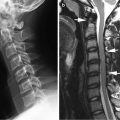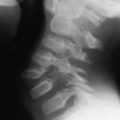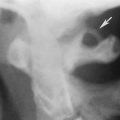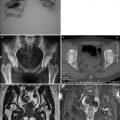(1)
Department of Pediatric Radiology, University of Texas Medical Branch, Galveston, TX, USA
Abstract
In this chapter cervical spine fractures and dislocations are discussed. The mechanisms of injury involved with flexion, extension, rotational, and axial loading forces are described in detail. The various fractures and dislocations are profusely illustrated and CT and MR are liberally used to complement the plain film findings.
Introduction
Mechanisms of injury of the cervical spine are the same in infants and young children as in adults, but the results may be different. Older children and adolescents can be considered adults in terms of types and locations of fractures. Overall, more fractures are induced by flexion forces than by extension forces, and in this regard, because the apex of the flexion curve in infants and young children is through the upper cervical spine [1], it is not a surprise that more fractures occur at this level than lower in the cervical spine [2–5]. Thereafter, as the child grows older, and into adolescence, the apex of the flexion curve is transferred to the midcervical spine as shown earlier (see Fig. 2.4). As a result, injuries become more common at this level.
Forces Involved in Cervical Spine Injury
Basically there are four forces involved in trauma to the cervical spine: flexion, extension, rotational, and axial loading forces (Fig. 5.1). Flexion and anterior rotational injuries are more common than extension and posterior rotational injuries. Pure axial loading injuries are less common than any of the foregoing types of injuries, but in any given case, more than one force often is at play. Nonetheless, it is important to appreciate that each of these forces leads to definitive patterns of injury, both bony and soft tissue. In fact, detailed analysis of the initial lateral cervical spine radiograph usually allows one to deduce, from the abnormalities detected, which forces were involved.


Fig. 5.1
Forces encountered in trauma to the spine. (a) Flexion forces. (b) Extension forces. (c) Rotational forces. (d) Axial compression forces
Plain Film Views Required
Before the advent of computerized tomography, a complete five-view cervical spine series usually was obtained. This consisted of AP, lateral, both oblique, and open-mouth odontoid views of the cervical spine, but in actual fact, the two views that were most productive were the lateral and open-mouth odontoid views. The swimmer’s view was frequently added to visualize the lower cervical spine, but currently, if there is difficulty visualizing this portion of the cervical spine, CT evaluation is obtained. As a result, on initial investigation of cervical spine trauma the lateral cervical spine and open-mouth odontoid views are most important. However, in infants and young children, obtaining proper plain films can be a problem, especially the open-mouth odontoid view [6]. Generally speaking, if the upper cervical spine or the lower cervical spine is not adequately visualized on the lateral and open-mouth odontoid views, one probably should proceed to CT examination of these areas. This generally leads to rapid disposition of the problem, but in infants and children aged 5 years and under, such CT studies may not be required. This is especially true of the upper cervical spine, where a normal lateral cervical spine view may suffice [6].
In our institution we attempt to obtain a proper open-mouth odontoid view twice, but if the second attempt fails, and clinical/radiographic suspicion of injury is low and the lateral view normal, we stop the study. This is possible because in infants and young children, odontoid fractures generally occur through the synchondrosis between the dens and the body of C2 [7–9], and thus, almost invariably the presence of such a fracture can be excluded on lateral views of the cervical spine. Clearly, if this cannot be accomplished, one should proceed to CT evaluation, but most often one can feel secure with a normal lateral and open-mouth odontoid view [6]. This is not true of the lower cervical spine, for if the lower cervical spine is not visualized and the presence of injury in this area is suspected, one should proceed to CT imaging.
Additional Imaging of Cervical Spine Trauma
There is no question that most initial information regarding serious cervical spine injuries can be obtained from the lateral cervical spine and open-mouth odontoid views, if one knows how to evaluate them. However, CT imaging, with reconstruction in various planes, is mandatory for further evaluation and also is useful in detecting otherwise occult fractures of the cervical spine and base of the skull [10–14]. It should be noted, however, that many of these latter fractures are not important in terms of cervical spine instability. Indeed, when these injuries are identified it is important to convey their proper significance to the referring physician, and their family. The reason for this is that to the lay public, any mention of a cervical spine fracture results in considerable anxiety. It is important, therefore, to indicate to people who consult us that while certain injuries are critical and unstable and need immediate attention, others, although still important and painful, are not unstable, will not result in a serious consequence, and will resolve with time.
Magnetic resonance imaging also is useful in acute trauma, but it generally is used in selected cases. Basically, it should be used when cord injury is suspected on the basis of clinical or imaging findings. There is no question that MRI is excellent in delineating spinal cord and soft tissue injury, but it should be used only when information regarding these anatomic regions is required.
Finally, in any case plain films can be augmented by obtaining flexion–extension views [15]. However, in one study [16], it was determined that if the lateral and open-mouth odontoid views were normal, flexion–extension views offered very little further information. This point notwithstanding, there still are instances in which the flexion view will demonstrate a formerly occult posterior ligament injury. Of course, flexion views should not be obtained when initial plain film examination clearly shows instability of the spine.
Flexion views can be obtained in cooperative patients with the patient flexing his or her neck on request. In less cooperative patients, and indeed in unconscious patients, flexion views of the cervical spine still can be obtained if the radiologist flexes the spine in increments. Each flexion maneuver should be recorded with a portable film, and once this has been analyzed and it has been determined that no abnormality is present, the neck can be flexed slightly more. Eventually, full flexion will be obtained, and one can determine whether an underlying injury is present.
Plain Film Signs of Cervical Spine Instability
Signs of cervical spine instability may be very graphic and florid or extremely subtle. It is important that one becomes thoroughly familiar with all these signs, both on plain films and on CT. These are dealt with in more detail throughout this chapter, but an overall view is presented in Table 5.1. In this regard, the most important job for the initial observer of the cervical spine imaging study is to determine whether cervical spine instability is present [17, 18]. There is no question that although many minor injuries result in prolonged pain and discomfort to the patient, and the patient may not consider the pain to be minor, the most important task to be accomplished when first inspecting the cervical spine plain film series is to determine whether cervical spine instability is present.
Table 5.1
Signs of cervical spine instability
Finding | Mechanism of injury |
|---|---|
Anterior vertebral body displacement | Flexion, anterior rotation |
Posterior vertebral body displacement | Extension, posterior rotation |
Disk space narrowing | Flexion, anterior rotation |
Disk space widening | Extension, posterior rotation |
Teardrop fracture | Flexion, extension |
V-shaped apophyseal joints | Flexion, anterior rotation |
Wide apophyseal joints | Flexion, rotation |
Dislocated apophyseal joints | Flexion, anterior rotation |
Offset or locked apophyseal joints | Flexion, anterior rotation |
Bilateral pars fracture | Extension |
Increased interspinous distance | Flexion |
Increased predental distance | Flexion, anterior rotation |
Offset lateral masses of C1 | Axial loading |
Burst (fat) vertebra | Axial loading |
Dens fractures | Flexion, extension, rotation |
Prevertebral swelling | Flexion, extension, rotation |
Specific Injuries
It is important to understand the underlying mechanics of the various injuries sustained in the cervical spine, and to this end, cervical spine injuries are discussed, by mechanism, under the following headings: lower cervical spine (C3–C7) injuries and upper cervical spine (C1 and C2) injuries. The mechanisms of flexion, extension, lateral flexion, rotational, and axial compression have been illustrated earlier (Fig. 5.1), and it might be noted that in many cases more than one mechanism is at play.
Lower Cervical Spine Injuries
Flexion Force Induced Injuries
In older children, injuries of the lower cervical spine induced by flexion most commonly occur in the midportion of the spine. Characteristically with flexion forces there is anterior compression and posterior distraction. The compressive forces are dissipated through the vertebral body (usually the anterior portion), and distraction forces are dissipated through the apophyseal joints and ligaments between the spinous processes and neural arches (Fig. 5.2). Anterior vertebral body compression can be seen with or without an associated avulsion, inferior corner, teardrop fracture. This fracture results when the anterior longitudinal ligament is stretched and pulls off a piece of bone [19]. In children, this fragment often comes from the ring epiphysis [20]. Distracting forces posteriorly cause the neural arches to separate so that the intraspinous distance increases [21], with or without associated avulsion fractures (Fig. 5.2). In addition, similar ligament disruption can cause the posterior aspect of the disk space to widen as well. Overall, however, the intervening disk space usually is narrowed with flexion force induced injury (Figs. 5.3 and 5.4).




Fig. 5.2
Flexion force induced injuries: diagrammatic representation. With flexion, anterior compression forces result in wedge-like compression of the vertebral body (1), teardrop fractures (2), disruption of the apophyseal joints (3), and widening of the intraspinous distance (4), with or without avulsion fractures (5). Also note that the superior vertebral body is anteriorly displaced on the inferior vertebral body

Fig. 5.3
Flexion-induced injuries: vertebral compression and teardrop fractures. (a) Note compression of C5 and a large teardrop fracture (arrow). There is no prevertebral soft tissue swelling. There may be very minimal widening of the apophyseal joint between C5 and C6. C5 is slightly retropulsed. (b) Axial CT demonstrates the compressed/fragmented vertebral body of C5 (arrows). (c) Another patient with anterior compression of C7, a teardrop fracture from the superior corner of the vertebral body (arrow), and widening of the intraspinous distance between C6 and C7 (X). The apophyseal joints are minimally widened and the superior facette slightly anteriorly positioned. (d) Another patient. Note teardrop fractures at two levels (arrows). At the upper level the teardrop arises from the inferior corner of the vertebral body. The vertebral body is compressed, minimally retropulsed and the disk space between it and the next vertebra (C5) is slightly narrowed. At the lower level, at C7, a superior corner teardrop fracture is noted and there is minimal compression of the vertebral body. The posterior elements and apophyseal joints appear normal. Again note that there is no prevertebral soft tissue swelling

Fig. 5.4
Flexion-induced injuries: value of CT and MR. (a) Note the small anterior teardrop fracture (arrow) and the associated compressed vertebra (C4). There is minimal retropulsion. The posterior elements appear normal. (b) Axial CT demonstrates the crushed and fragmented vertebral body (arrows). (c) CT, Sagittal reconstruction demonstrates the teardrop fracture (arrow), slight compression of the vertebral body and slight retropulsion. (d) Sagittal MR T2 weighted study demonstrates slightly increased signal in the involved vertebral body (arrow), slight retropulsion, and widening of the spinal cord with some increased signal consistent with spinal cord contusion
Anterior compression of the vertebral body also results in loss of vertebral body height and an anterior, wedge-like configuration, often involving the superior vertebral bony plate more than the inferior plate. Prevertebral soft tissue swelling is variable, and a teardrop fracture, usually involving the inferior, anterior corner of the vertebral body, often is present (Figs. 5.3 and 5.4). Increase in interspinous distance also can be seen on frontal views of the cervical spine [21], but it is so evident on lateral view that the frontal view findings are supplementary.
In more severe compressive injuries of the vertebral body, usually associated with some degree of axial loading, the vertebral body is crushed and expands in all directions (Fig. 5.5). The most important of these directions is posterior, for the bony fragments then encroach upon the spinal canal and compress the spinal cord. This phenomenon, to one degree or another, is common with flexion-induced compression fractures (Fig. 5.5). All the features of flexion-induced fractures of the vertebra, but especially the bony injuries are most vividly demonstrated with reconstructed CT studies, but for soft tissues and the spinal cord, MR imaging is best (Fig. 5.6).



Fig. 5.5
Flexion-induced injuries: Value of CT and MR. (a) Sagittal reconstructed CT study demonstrates compression of C5, an anterior tear drop fracture, and a slight degree of retropulsion of C5 into the spinal canal (arrow). (b) Coronal reconstructed CT demonstrates that two vertebral bodies are involved (arrows). (c) Axial CT study of the upper vertebral body demonstrates complete crushing of the vertebral body (arrows). (d) Axial CT of the lower vertebral body demonstrates a single vertical fracture (arrow). (e) Sagittal MR, T1 weighted study demonstrates the compressed and slightly retropulsed vertebra and teardrop fracture (arrow). (f) Sagittal MR T2 weighted study demonstrates slightly increased signal in C5 (arrow). Also note the teardrop fracture. There is very minimal increase in signal in the vertebral body below (C6). There is slight retropulsion of C5. The cord appears a little thickened in the area and there is slightly increased signal consistent with a mild contusion

Fig. 5.6
Flexion-induced injuries, minimal plain film findings, value of CT and MR. (a) The cervical spine basically appears near normal. There is no soft tissue swelling. The only suspicious finding is slight increased in the interspinous distance between C5and C6 (arrow). The superior apophyseal joint facette also is slightly anteriorly positioned. (b) CT study sagittal reconstruction demonstrates the increased interspinous distance to be valid (arrow). In addition there is slight anterior displacement of C4 (C4) on C5. (c) Sagittal MR, T2 weighted study demonstrates extensive high signal in the upper posterior soft tissues consistent with a hyperflexion injury and distracting forces posteriorly. (d) Another patient. Note compression of C6 along with a superior teardrop fracture (arrow). There may be slight soft tissue swelling causing bulging into the posterior wall of the trachea. At the level of C4 and C5 the interspinous distance appears increased (posterior arrow). (e) Sagittal MR T2 weighted study demonstrates slight increased signal in the body of C6 (anterior arrow) and extensive high signal of the soft tissues over the upper posterior cervical spine (posterior arrow). (f) MR axial T2 weighted study demonstrates the same posterior soft tissue edema along with low signal hematoma (arrows)
Compression fractures of C3 are rare in any age group. However, they do occur, and the findings are no different from those associated with compression fractures occurring elsewhere (Fig. 5.7). In these cases, however, it is important to appreciate that although C3 may appear to be severely wedged, the wedging probably was present prior to the injury in the form of normal wedging.


Fig. 5.7
Flexion force injury: less common location (C2–C3). (a) Note that C2 is anteriorly displaced on C3. There is an anterior avulsion (teardrop) fracture (anterior arrow). The prevertebral soft tissues are slightly prominent. The apophyseal joint between C2 and C3 is markedly disrupted, and the perched facette sign (posterior arrow) is present. (b) Axial CT study demonstrates the fragmented vertebral body of C3 (arrows). (c) Sagittal T2 MRI image demonstrates the posterior bulging of C3 into the spinal canal. The subarachnoid space is compromised, and there is slight indentation on the cord (arrows). No contusion is present. The wedge-shaped configuration of C3 in (a) probably is due not to the fracture but to a normal variation commonly seen in infants and young children (see Fig. 2.15) (Reproduced with permission from LE Swischuk, Emergency Radiology of the Acutely Ill or Injured Child, 4th ed. Lippincott Williams & Wilkins, Baltimore, 2000)
Abnormalities of the apophyseal joints with flexion-induced injuries center around joint space disruption, and in some cases fracturing of the facettes and pedicles. These fractures are not readily detected on plain films and usually come to discovery on subsequent CT studies. On plain films the apophyseal joint can be separated and widened, or more importantly, V-shaped (Fig. 5.8). The superior facette also can slide forward on the inferior facette with less coverage of the inferior facette than normal (Fig. 5.8). In more severe cases the posterior corner of the superior facette becomes perched on the anterior corner of the inferior facette, leading to the “perched facette” sign (Fig. 5.9). With further anterior motion the superior facette jumps over the inferior facette and becomes locked on the inferior facette, constituting the “jumped” or “locked” facette sign (Fig. 5.10).




Fig. 5.8
Flexion-induced injury: apophyseal joint disruption. (a) Note the V-shaped apophyseal joint (arrow) and the anteriorly displaced superior facette. There is suggestion of minimal compression of the anterior superior aspect of the inferior vertebral body (?fx). (b) In this patient note the wide, slightly V-shaped apophyseal joint (arrow) and compare with the normal apophyseal joint above it. The apophyseal joint below it also is disrupted and the joint space widened. (c) Additional findings include posterior widening of the intervertebral disk space (Os) and widening of the intrasponous distance (X)

Fig. 5.9
Flexion force injuries: perched facette. (a) Note that the posterior inferior corners of both superior facettes (upper posterior arrows) are perched on the anterior superior corners of the lower vertebral body facettes (lower posterior arrows). The superior vertebral body is displaced on the inferior vertebral body, and there is minimal compression of the upper corner of the lower vertebral body (anterior arrow). (b) T1 sagittal MR study demonstrates the dislocated vertebral bodies (arrow) disrupted disk, some blood anterior to the vertebral bodies, and marked impingement of the spinal canal and cord. (c) T2 MR study demonstrates similar findings but more vividly demonstrates the cord contusion, small central hematoma, and edema around the fracture site (arrows)

Fig. 5.10
Flexion force injuries: locked/jumped facettes. (a) The facettes are locked (posterior arrow), and there is complete dislocation of the vertebral bodies (anterior arrow). The involved intravertebral disk space is narrow. (b) On this axial CT image, the superior, dislocated vertebral body (arrows) is visible on the same plane as is the inferior vertebral body (X). Fractures of the lamina are present on the right. (c) Sagittal reconstructed CT study demonstrates the overlapping, “locked” facette (arrow). (d) Another patient. Note anterior dislocation of C4 on C5 (anterior arrow). The superior facette of the associated apophyseal joint has jumped over the inferior facette and is now locked (posterior arrow). (e) Sagittal T2 weighted MR study. Note the same dislocation as seen on plain films (anterior arrow). There also is posterior displacement (protrusion) in to the spinal canal with obliteration of the subarachnoid space and some compression of the spinal cord leading to mild contusion (posterior arrow). High signal edema is seen in the posterior soft tissues
In some cases of flexion-induced injury no bony abnormality is evident, yet there is occult para-apophyseal joint and posterior interspinous ligament damage. This can be subtly apparent on initial lateral views of the cervical spine, as the interspinous distance will be slightly increased and the apophyseal joints slightly widened, or even slightly V-shaped. In other cases, however, only subsequent flexion views will detect the underlying ligamentous instability (Fig. 5.11), and finally, avulsion fractures of the spinous tips can occur, and in the lower cervical spine these constitute the classic clay shoveler’s fracture (Fig. 5.12).



Fig. 5.11
Flexion force injury: occult ligament injury. (a) There is very slight anterior displacement of C4 on C5 (arrow). The prevertebral soft tissues are questionably thickened in the area. (b) The X demarcate the actual degree of slippage. (c) With flexion, there is now anterior displacement of C4 on C5 and C5 on C6 (X). The associated apophyseal joints also are slightly widened (arrows). (d) In this patient there is suggestion of widening of the intraspinous distance between C5 and C6 (?). (e) With flexion, the posterior disk space widens and C5 is slightly anteriorly displaced on C6 (X). Posteriorly the intraspinous distance becomes wider (X)

Fig. 5.12
Flexion force injury: spinous tip fracture. (a) Note spinous tip fractures of both C7 and T1 (arrows). (b) A very subtle spinous tip fracture (arrow). (c) CT study demonstrates the small bony fragment (arrow)
Extension Force Induced Injuries
In the lower cervical spine, injuries induced by extension force tend to occur more at the C6–C7 level than in the midspine as seen with flexion force injuries. With extension force injuries, compressive forces are present posteriorly while distracting forces occur anteriorly (Fig. 5.13). As a result, one can see anterior widening of the disk space [22] secondary to rupture of the anterior longitudinal ligaments (Fig. 5.13). At the same time a teardrop fracture can result from an avulsion of a corner of the vertebra by the anterior ligaments. Most often such fractures involve the upper anterior corner of the vertebra (Fig. 5.13). The apophyseal joints usually are not dislocated with this type of injury, but fracturing of the neural arch can occur. In addition, because of the posterior compressive forces present, leverage is applied to the neural arch and unilateral or bilateral pars fractures can occur.


Fig. 5.13
Extension force injuries: diagrammatic representation. Note anterior disk widening (1), a teardrop fracture (2), disruption of the apophyseal joints (3), and a fracture through the pars (4)
In the classic hyperextension injury shown in Fig. 5.14, bilateral pars fractures are seen. In addition anterior widening of the concomitant intervertebral disk space is as well as slight anterior subluxation of the upper vertebra. On CT imaging, pars fractures appear the same as they do in the upper cervical spine in the classic hangman’s fracture (see later: Fig. 5.30).


Fig. 5.14
Extension force injury: various findings. Note the widened disk space (anterior arrow) and slight anterior displacement of the superior vertebral body on the inferior vertebral body. Bilateral pars fractures are present (posterior arrow)
Hyperextension injuries are notorious for producing injury (contusion) to the spinal cord without any visible bony or ligamentous injury. This has been termed the SCIWORA injury [23, 24] and in the past was known as the “central cord syndrome.” In these cases, definite neurologic deficit referable to the lower cervical cord is present, and yet there is virtually nothing to see on plain films. In these cases, with hyperextension, buckling of the intracanalicular spinal ligaments results in cord compression and contusion. Magnetic resonance imaging is necessary for demonstrating this injury (see later: Fig. 5.48).
< div class='tao-gold-member'>
Only gold members can continue reading. Log In or Register to continue
Stay updated, free articles. Join our Telegram channel

Full access? Get Clinical Tree








